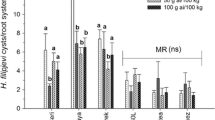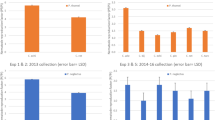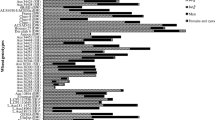Summary
Among the nematodes infesting chickpea (Cicer arietinum L.) plants in Syria, cyst nematode (Heterodera ciceri Vovlas, Greco et Di Vito) is the most important. It is uneconomical to grow chickpea in fields infested with cyst nematode and to control this nematode with nematicide. Therefore, investigations were conducted at ICARDA, Syria from 1987 to 1991 to identify sources of resistance to cyst nematode in 7258 lines of C. arietinum and 102 lines of eight annual Cicer species including C. bijugum K.R. Rech. (13 lines), C. chorassanicum (Bge) M. Pop. (3 lines), C. cuneatum Hochst. ex Rich. (3 lines), C. echinospermum P.H. Davis (8 lines), C. judaicum Boiss. (18 lines), C. pinnatifidum Jaub. & Sp. (18 lines), C. reticulatum Ladiz. (36 lines), and C. yamashitae Kitamura (3 lines). All lines were grown in a greenhouse at 15–25°C in pots containing soil infested with 20 eggs of the nematode g-1 soil. Nematode infestation was evaluated on a 0 to 5 scale based on number of females and cysts on roots. Resistance was found in one line of C. bijugum, six lines of C. pinnatifidum, and one line of C. reticulatum. No lines of C. arietinum, C. chorassanicum, C. cuneatum, C. echinospermum, C. judaicum, or C. yamashitae was resistant to cyst nematode. Plants with resistance have been recovered in the F3 generation from crosses between the cultigen and C. reticulatum, indicating the possibility of transfer of gene(s) for resistance to cyst nematode from wild to cultivated Cicer species.
Similar content being viewed by others
References
Caswell, E.P., I.J., Thomason & H.E., McKinney, 1985. Extraction of cysts and eggs of Heterodera schachtii from soil with an assessment of extraction efficiency. Journal of Nematology 17, 337–340.
Di, Vito, M. & N., Vovlas, 1990. Differential histological response of selected Cicer bijugum and C. arietinum lines to Heterodera ciceri. Nematologia mediterranea 18, 165–167.
Di, Vito, M., N., Greco, K.B., Singh & M.C., Saxena, 1988. Response of chickpea germplasm lines to Heterodera ciceri attack. Nematologia mediterranea 16, 17–18.
Di, Vito, M., N., Greco & M.C., Saxena, 1991. Effectiveness of soil solarization for control of Heterodera ciceri and Pratylenchus thornei on chickpea in Syria. Nematologia mediterranea 19, 109–111.
Greco, N., M.Di, Vito, M.V., Reddy & M.C., Saxena, 1984. A preliminary report of survey of plant parasitic nematodes of leguminous crops in Syria. Nematologia mediterranea 12, 87–93.
Greco, N., M.Di, Vito, M.C., Saxena & M.V., Reddy, 1988. Effect of Heterodera ciceri on yield of chickpea and lentil and development of this nematode on chickpea in Syria. Nematologica 34, 98–114.
Haware, M.P. & Y.L., Nene, 1980. Sources of resistance to wilt and root rots of chickpea. International Chickpea Newsletter 3, 11–12.
Jatala, P. & J., Bridge, 1990. Nematodes parasite of root and tuber crops. pp. 137–180. In: M., Luc, R.A., Sikora & J., Bridge (Eds) Plant Parasitic Nematodes in Subtropical and Tropical Agriculture. CAB International, Wallingford, U.K.
Ladizinsky, G. & A., Adler, 1976. Genetic relationships among annual species of Cicer L. Theoretical and Applied Genetics 48, 197–203.
Noel, G.R., 1986. The soybean cyst nematode. pp. 257–268. In: F., Lamberti & C.E., Taylor (Eds) Cyst Nematodes. Plenum Press, New York and London.
Pandey, G. & R.B., Singh, 1990. Screening of gram cultivars against root-knot nematode (Meloidogyne incognita). Current Nematology 1, 71–72.
Reddy, M.V. & K.B., Singh, 1984. Evaluation of a world collection of chickpea germplasm accessions for resistance to Ascochyta blight. Plant Disease 68, 900–901.
Saxena, M.C., N. Greco & M. Di Vito, 1992. Control of Heterodera ciceri by crop rotation. Second International Food Legume Research Conference, Cairo, Egypt, 12–16 April 1992 (Abstr.)
Seinhorst, J.W. & H.Den, Ouden, 1966. An improvement of Bijloo's method for determining the egg content of Heterodera cysts. Nematologica 12, 170–171.
Sharma, G.L. & B.N., Mathur, 1985. Reactions of chickpea cultivars to root-knot nematode, Meloidogyne incognita. International Chickpea Newsletter 12, 31–32.
Singh, K.B., M.Di, Vito, N., Greco & M.C., Saxena, 1989. Reactions of wild Cicer spp. lines to Heterodera ciceri. Nematologia mediterranea 17, 113–114.
Vovlas, N., N., Greco & M.Di, Vito, 1985. Heterodera ciceri sp. N. (Nematoda: Heteroderidae) on Cicer arietinum from Northern Syria. Nematologia mediterranea 13, 239–252.
Author information
Authors and Affiliations
Additional information
Joint contribution from Istituto di Nematologia Agraria, ICARDA and ICRISAT (International Crops Research Institute for the Semi-Arid Tropics), Patancheru P.O., A.P. 502 324, India.
Rights and permissions
About this article
Cite this article
Di Vito, M., Singh, K.B., Greco, N. et al. Sources of resistance to cyst nematode in cultivated and wild Cicer species. Genet Resour Crop Evol 43, 103–107 (1996). https://doi.org/10.1007/BF00126752
Received:
Accepted:
Issue Date:
DOI: https://doi.org/10.1007/BF00126752




